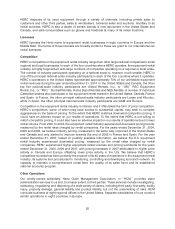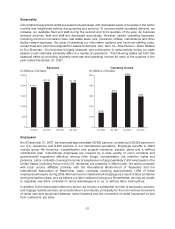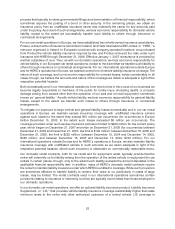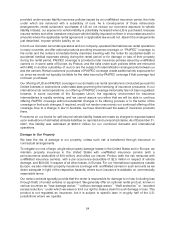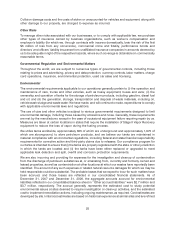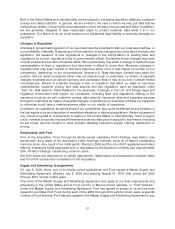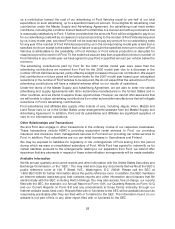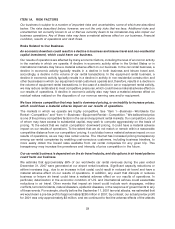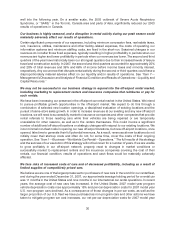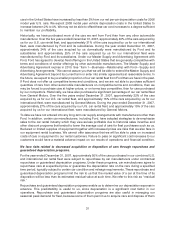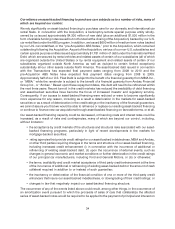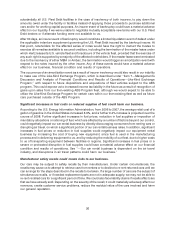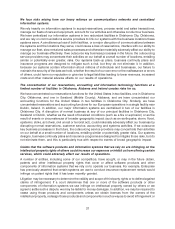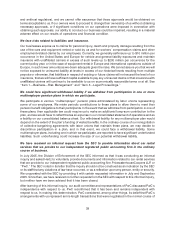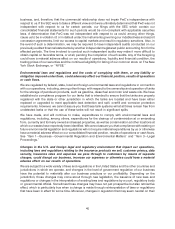Hertz 2007 Annual Report Download - page 50
Download and view the complete annual report
Please find page 50 of the 2007 Hertz annual report below. You can navigate through the pages in the report by either clicking on the pages listed below, or by using the keyword search tool below to find specific information within the annual report.well into the following year. On a smaller scale, the 2003 outbreak of Severe Acute Respiratory
Syndrome, or ‘‘SARS,’’ in the Toronto, Canada area and parts of Asia, significantly reduced our 2003
results of operations in Canada.
Our business is highly seasonal, and a disruption in rental activity during our peak season could
materially adversely affect our results of operations.
Certain significant components of our expenses, including minimum concession fees, real estate taxes,
rent, insurance, utilities, maintenance and other facility-related expenses, the costs of operating our
information systems and minimum staffing costs, are fixed in the short-run. Seasonal changes in our
revenues do not alter those fixed expenses, typically resulting in higher profitability in periods when our
revenues are higher and lower profitability in periods when our revenues are lower. The second and third
quarters of the year have historically been our strongest quarters due to their increased levels of leisure
travel and construction activity. In 2007, the second and third quarters accounted for approximately 25%
and 28% of total revenues and 36% and 66% of income before income taxes and minority interest,
respectively. Any occurrence that disrupts rental activity during the second or third quarters could have a
disproportionately material adverse effect on our liquidity and/or results of operations. See ‘‘Item 7—
Management’s Discussion and Analysis of Financial Condition and Results of Operations—Liquidity and
Capital Resources.’’
We may not be successful in our business strategy to expand into the off-airport rental market,
including marketing to replacement renters and insurance companies that reimburse or pay for
such rentals.
We have been increasing our presence in the off-airport car rental market in the United States. We intend
to pursue profitable growth opportunities in the off-airport market. We expect to do this through a
combination of selected new location openings, a disciplined evaluation of existing locations and the
pursuit of same-store sales growth. In order to increase revenues at our existing and any new off-airport
locations, we will need to successfully market to insurance companies and other companies that provide
rental referrals to those needing cars while their vehicles are being repaired or are temporarily
unavailable for other reasons, as well as to the renters themselves. This could involve a significant
number of additional off-airport locations or strategic changes with respect to our existing locations. We
incur minimal non-fleet costs in opening our new off-airport locations, but new off-airport locations, once
opened, take time to generate their full potential revenues. As a result, revenues at new locations do not
initially cover their start-up costs and often do not, for some time, cover the costs of their ongoing
operation. See ‘‘Item 1—Business—Worldwide Car Rental—Operations.’’ The full results of this strategy
and the success of our execution of this strategy will not be known for a number of years. If we are unable
to grow profitably in our off-airport network, properly react to changes in market conditions or
successfully market to replacement renters and the insurance companies covering the cost of their
rentals, our financial condition, results of operations and cash flows could be materially adversely
affected.
We face risks of increased costs of cars and of decreased profitability, including as a result of
limited supplies of competitively priced cars.
We believe we are one of the largest private sector purchasers of new cars in the world for our rental fleet,
and during the year ended December 31, 2007, our approximate average holding period for a rental car
was 11 months in the United States and nine months in our international car rental operations. In recent
years, the average cost of new cars has increased. In the United States, 2007 model year program
vehicle depreciation costs rose approximately 15% and per-car depreciation costs for 2007 model year
U.S. non-program cars declined. As a consequence of those changes in per-car costs, as well as the
larger proportion of our U.S. fleet we have purchased as non-program cars and other actions we have
taken to mitigate program car cost increases, our net per-car depreciation costs for 2007 model year
30


